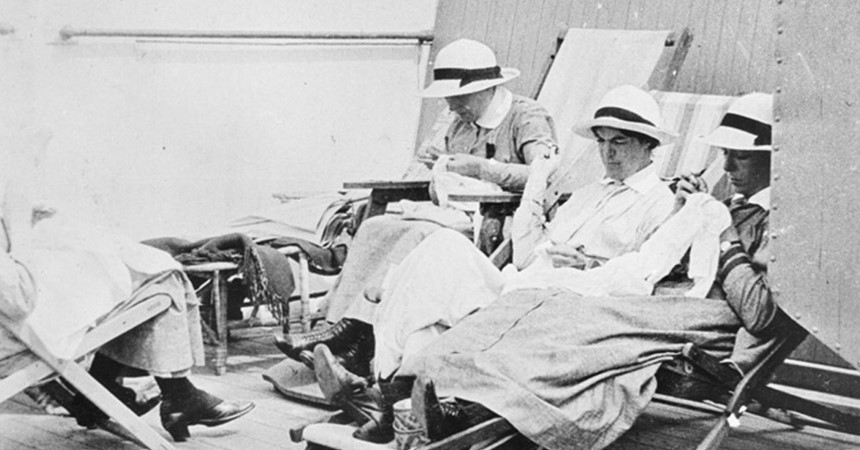For many Australians the phrase “First World War” initially conjures images of troops scrambling up the steep cliffs of Gallipoli under fierce enemy fire or the muddy trenches of the Western Front.
Anzac Day is an occasion to remember the 60,000 Australians who lost their lives in that war and those who have died in later wars. One hundred years on, we are coming to a more rounded picture of what a war involves and who is affected, with attention focusing on those at home as well as the personnel who support military campaigns. This includes medical personnel – nurses, medical officers, stretcher bearers and orderlies.
The authorities were poorly prepared for casualties from the Gallipoli landing. Generals plan for victory, not defeat – it was envisaged that the Allies would quickly gain control of the Peninsula and any casualties could be cared for in Turkish hospitals. As a result, there were not enough hospital ships standing by for the wounded. Sister Sophie Durham MID from Singleton was one of seven nurses on the hospital ship “Gascon” on 25 April 1915. These seven nurses had to care for almost 600 patients. One of Sophie’s colleagues commented that they could do nothing for the men except dress wounds, there was simply no time to wash them and make them comfortable in spite of their dirty state and the heat of the day. When space on hospital ships ran out, casualties were evacuated to anything that would float, including a ship used to transport mules to the landing site that had not been cleaned of droppings. Nurses in Egypt who received the wounded from this ship saw a hundred men die from infected wounds as a result. (Source: Susanna de Vries, Australian Heroines of World War One.)
As the Gallipoli campaign wore on, the organisation of medical treatment did not always improve. In August 1915 No 3 Australian General Hospital (3 AGH) was sent to the Greek island of Lemnos to treat evacuated casualties. On arrival, hospital staff found that their stores, including tents and food, had been left behind in Egypt. Writing to her family, Sister Beryl Henson from Mayfield spoke of having practically nothing for the men, only a few mattresses for the worst cases, and how the doctors of 3 AGH had to beg for food and eating utensils from other units on the island. Of the nurses’ diet, she wrote that, “at first we all lived on vilely sour bread, boiled rice, stale bacon & marmalade & tea with a suspicion of condensed milk”. (Source: Emily Beryl Henson Papers, Australian War Memorial). Even water was in short supply – in the first days both staff and patients were allowed a ration of one cup of water per day for all purposes. It is not surprising that in the circumstances many of the nurses became ill.
Nurses arriving in France from the Gallipoli campaign found the facilities better organised but their experiences were just as taxing. At times of major actions, such as the Battle of the Somme in 1916, hospitals routinely dealt with hundreds of wounded, arriving within a matter of hours. Doctors were faced with pressure from military authorities to treat men and return them to battle as quickly as possible – a terrible challenge to their vocation. Casualty clearing stations close to the front line were vulnerable to air raids. It took a cool nerve to work in these hospitals and some nurses (and other staff) were evacuated to base, suffering from shell shock. Head Sister Louisa Stobo RRC from Maitland was at one such hospital in July 1917 that suffered repeated night time raids. She was later awarded the Royal Red Cross 1st class for her calm and collected management of the nursing staff during this harrowing time.
At least eighty women from the Hunter region served as military nurses between 1914 and 1919. The experiences of Sisters Durham, Henson and Stobo were typical of Australian nurses who served. Nearly 4000 Australian and NZ women served in military hospitals during the First World War. Thirty-six Australian nurses died on active service – one lost at sea when a hospital ship was torpedoed, the others from illnesses contracted during their work, such as malaria and influenza. Seventeen New Zealand nurses, too, lost their lives, including ten who were lost at sea when the troopship “Marquette” was sunk by submarine attack. Their numbers are small compared with casualties amongst soldiers, but we must not forget these women who also made the supreme sacrifice.
Christine Bramble is the author of Sisters of the Valley: First World War Nurses from Newcastle and the Hunter Region, Royal Newcastle Hospital Graduate Nurses’ Association Inc. Please visit huntervalleygreatwarnurses.com.






















































































